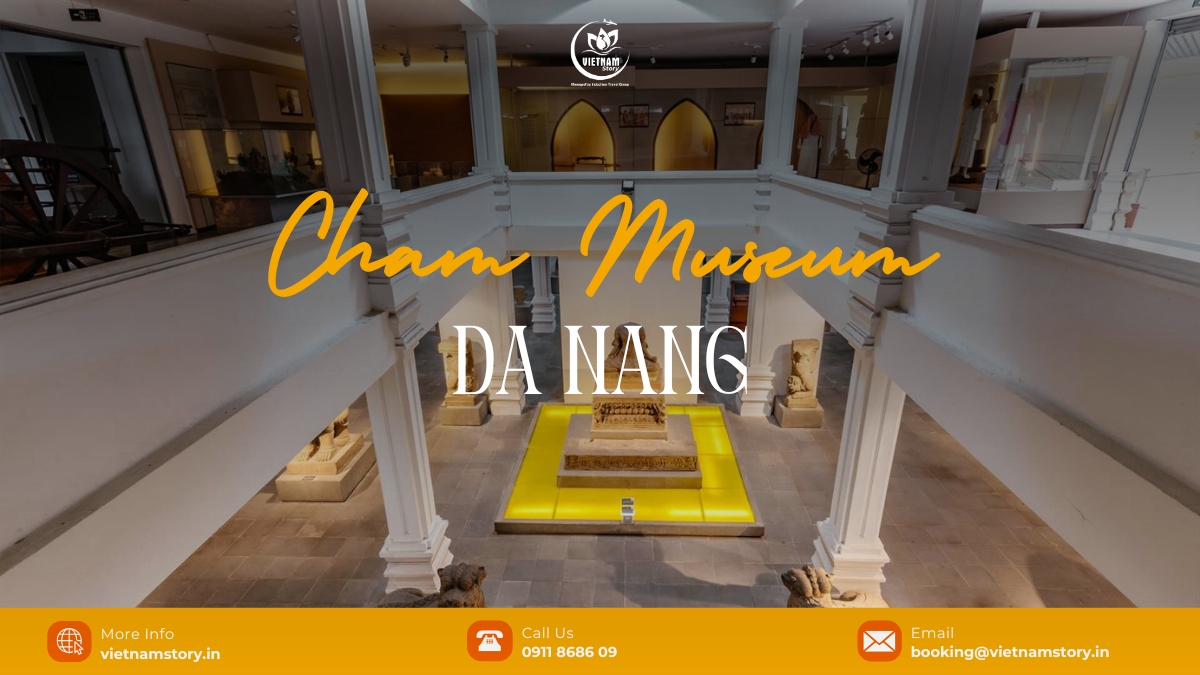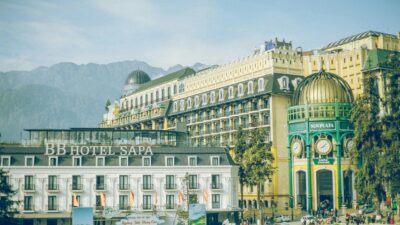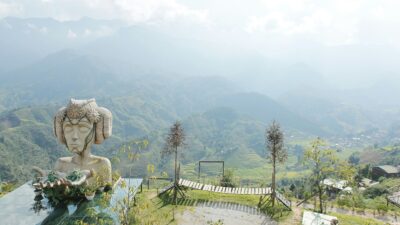Cham Cultural Museum demonstrates the deep, ancient connection between the two cultures of Vietnam and India. It’s not just a collection of old stones, it is a profound story of art, faith, and a shared heritage that echoes the epics and deities of India. Let Vietnamstory.in be your guide and show you why this museum is an essential stop on your Vietnamese adventure.

What is the Cham Museum?
The Cham Museum is a treasure house, the single most important collection of sculptures and artifacts from the ancient Champa Kingdom, which flourished in Central Vietnam from the 2nd to the 17th century. This kingdom was deeply influenced by Hinduism (primarily Shaivism) and later, Buddhism, and its art is a breathtaking testament to this cultural fusion.
Location & Contact
- Address: No. 02, 2 Thang 9 Street, Binh Hien Ward, Hai Chau District, Da Nang City, Vietnam. The museum is located at a major roundabout right across from the iconic Dragon Bridge, making it very easy to find.
- Phone: (+84) 236 3574 801
Key facts at a glance
- Official name: Museum of Cham Sculpture (Bảo tàng Điêu khắc Chăm).
- Founded: The museum was established in 1919, after construction from 1915-1919, making it the oldest museum in Da Nang.
- Official status: It has been recognized as a first-class national museum since 2011, a testament to its cultural significance.
- Collection size: The museum houses a staggering collection of over 2,000 artifacts. Around 500 of the most exquisite pieces are on public display.
- Total area: The entire complex covers 6,673 square meters, with the beautiful galleries themselves occupying 2,000 square meters.
Why should you visit?
This is the world’s largest and most comprehensive collection of Cham sculpture. There is no other place on earth where you can witness the artistic evolution of this fascinating Hindu-Buddhist kingdom. For an Indian traveler, it’s like discovering a long-lost chapter of your own cultural history, retold in sandstone and terracotta on the shores of Vietnam.
A journey through history: The Museum’s story
The museum itself has a fascinating history, born from a desire to preserve a culture that was at risk of being lost to time.
The French Archaeologists & The Founding of a Museum
The story begins with French scholars from the renowned École française d’Extrême-Orient (EFEO). In the late 19th century, figures like Charles Lemire began collecting Cham artifacts that were scattered around ancient temple sites like My Son and Tra Kieu. They realized these priceless sculptures needed a dedicated home.
The true visionary, however, was archaeologist Henri Parmentier. It was he who, in 1902, proposed the design for a museum. He meticulously planned the layout, ensuring the architecture itself would honor the art within. When the museum opened in 1919, Parmentier also published its first catalog, introducing the world to the wonders of Champa.
READ MORE: The ultimate guide to My Son Sanctuary: Vietnam’s lost kingdom
Architecture: A fusion of East and West

The building’s design, brought to life by French architects Delaval and Auclair, is a masterpiece in itself. It’s a unique blend of European Gothic structural elements with traditional Cham temple motifs. Look closely at the soft arches, the pyramid-shaped gabled roofs, and the geometric windows – you’ll see they echo the designs of the ancient Cham towers you can still visit at My Son.
Our favourite part is the interior. The architects designed the galleries with open rooms and large windows, allowing natural light to flood in and illuminate the sculptures. This isn’t a dark, stuffy museum; it’s a bright, airy space that lets the art breathe and tell its story, just as it would have in its original open-air temple setting.
Evolution and Modern Recognition
The museum has grown over the decades. It was first expanded in the 1930s, then underwent a major restoration and expansion from 2002-2009. More recently, a significant renovation from 2016-2017 modernized the facilities and added new exhibition space.
In a wonderful recognition of its century-long legacy (it celebrated its 100-year anniversary in 2019), the museum was officially designated a “historical relic site of the city” in 2023. It remains a vibrant, evolving institution dedicated to preserving this incredible culture.
A thematic walk through Champa Art & Beliefs
The museum is cleverly organized into galleries based on the regions where the artifacts were discovered, which also correspond to different artistic periods. Walking through them is like traveling through time.
Main galleries & Key art styles
- Mỹ Sơn Gallery: Representing the golden age of Champa art (7th-8th centuries), this gallery holds masterpieces from the kingdom’s most sacred temple complex. Don’t miss the Mỹ Sơn E1 Pedestal. This incredible sandstone altar is decorated with scenes of ascetics playing instruments, dancing, and meditating in a forest setting, likely representing life on the mythical Mount Meru, the home of the Hindu gods. Also, look for the pediment that stunningly depicts the Hindu creation story of the Dawning of the Lotus Era, where Brahma emerges from a lotus flower that grows from Vishnu’s navel. The detail is simply extraordinary.
- Đồng Dương Gallery: This gallery showcases a powerful shift towards Buddhist influence (9th-10th centuries). The absolute star is the Tara Bodhisattva, a magnificent bronze statue that radiates grace and compassion. It is the largest Cham bronze sculpture ever found and is a world-class masterpiece of Asian art. Its serene expression and intricate details will leave you speechless.
- Trà Kiệu Gallery: This gallery holds some of the most narrative and debated pieces (4th-8th centuries). The highlight is the famous Trà Kiệu Pedestal. This altar is adorned with intricate carvings depicting scenes that many scholars, including the French archaeologist Jean Boisselier, believe are from the Hindu epic Ramayana. You can see figures that resemble Sita’s abduction, the monkey army of Hanuman, and the battle in Lanka. It’s a fascinating puzzle for historians and a delightful point of connection for anyone familiar with the epic.
- Tháp Mẫm Gallery: Showcasing a later, more stylized period (12th-13th centuries), the art here is bold and powerful. You’ll see many mythical creatures, including the impressive Gajasimha, a hybrid guardian beast with the body of a lion and the head of an elephant. This art reflects a shift in aesthetic, moving towards more ornate and monumental forms.
READ MORE: Hoi An Japanese Bridge: A timeless symbol
Beyond the main galleries
The journey doesn’t end there! There are several other galleries dedicated to artifacts from the provinces of Quảng Nam, Quảng Ngãi, and Bình Định, each with its own distinct style. A recent and very important addition is the Cham Culture showroom, which features artifacts and information about contemporary Cham life, reminding us that this culture is still very much alive.
Cham culture & Its legacy
Your journey of discovery shouldn’t end when you leave the museum.
The living legacy: Cham People today
The Cham are not an extinct civilization from history books. They are a living ethnic group in Vietnam today, one of our country’s 54 recognized ethnic minorities. Their contemporary communities are primarily in the sunny southern provinces of Ninh Thuận and Bình Thuận, where they have preserved their language, script, traditional crafts (like weaving and pottery), and unique religious practices.
Beyond the museum
After seeing the sculptures, Vietnamstory.in strongly recommends you connect them to their original homes. The museum is a starting point, not an end.
- From Da Nang, you must take a day trip to the magnificent My Son Sanctuary. This UNESCO World Heritage site is the actual temple complex where many of the museum’s greatest masterpieces were discovered. Walking among those ancient brick towers after seeing the sculptures is an unforgettable, full-circle experience.
- If your travels take you further south, visit the Po Nagar Cham Towers in Nha Trang. Unlike My Son, this is a living religious site where Cham people still come to practice their faith. Seeing the active worship will connect everything you learned in the museum to the present day.
A guide for the Indian traveler

Here is the practical information you need.
Visitor essentials & Ticket information
- Opening hours: Officially 7:30 AM to 5:00 PM (17:00), every day of the week. (Note: Sometimes hours can vary slightly, so arriving between 8:00 AM and 4:00 PM is always a safe bet).
- Ticket Price: This is very affordable for a world-class museum experience.
- Adults: 60,000 VND
- Students: 10,000 VND (with valid ID)
Enhancing your experience
- Audio guide: This is a fantastic feature! The museum offers a free audio guide accessible on your smartphone. Just connect to the museum’s Wi-Fi, scan the QR codes placed next to the key artifacts, and you’ll get a detailed explanation in English, French, or Vietnamese. It’s like having a personal curator in your pocket.
- Guided tours: For groups, you can book a guided tour in advance. This is an excellent way to get deeper insights from a knowledgeable local guide.
Important rules & what to expect
- Please do not touch the artifacts. They are thousands of years old and very fragile.
- Large bags and backpacks must be stored in the free lockers near the entrance.
- Photography without flash is generally allowed.
- Be respectful of the space and other visitors.
Is it worth visiting? Absolutely, one hundred percent. For an Indian traveler, this museum is more than just an attraction; it’s a bridge across time and sea. You will see familiar figures—Shiva, Ganesha, Vishnu, Garuda, Naga—rendered in a unique and powerful artistic language. It is a profound experience to witness how these shared beliefs blossomed so beautifully here in Vietnam.
Conclusion
The Cham Museum is not just a building with statues; it is the soul of an ancient kingdom and a vibrant testament to the enduring cultural dialogue between India and Southeast Asia. It’s a place of history, art, and a surprising sense of familiarity.
As you plan your trip to Vietnam, Vietnamstory.in urges you to set aside a morning or afternoon for this remarkable place. It will deepen your understanding of our country and reveal a beautiful, shared story written in stone. We look forward to welcoming you and perhaps even sharing this experience with you in person. Please include the Cham Museum in your Vietnam Story itinerary – you will be so glad you did.











